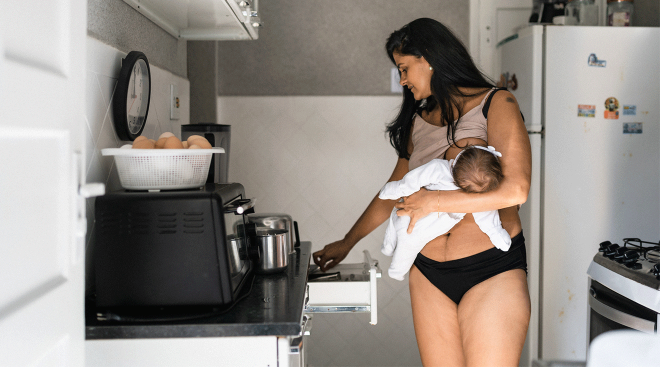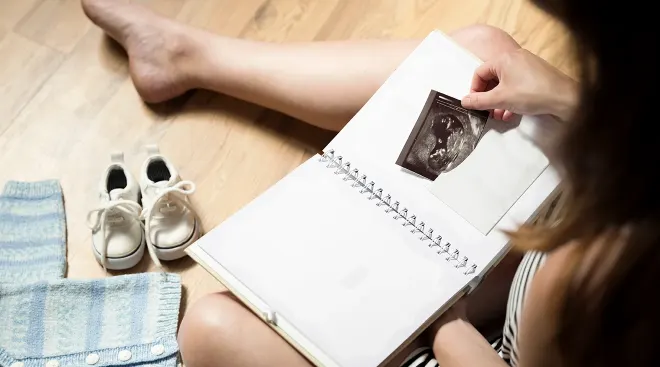- Congrats! You've got four weeks to go—at least until your due date. No guarantee that baby will show up on time.
- Baby is just shy of 6 pounds—give or take—at this stage of the game.
- You’ll be seeing your ob-gyn or midwife weekly from here on out. If you didn’t get your Step B test yet, it’ll most likely be happening this week. It’s just a gentle swab of the vaginal area and rectum (it sounds worse than it is). If you’re positive for the bacteria, don’t worry—you’ll get antibiotics at delivery to protect baby.
Baby could decide to arrive any day now, so try to put in your final prep work at 36 weeks pregnant. Go over your plan for getting to the hospital and all the what-ifs. Get baby's car seat installed and pack your hospital bag, if you haven't yet. While you're at it, consider updating your boss and colleagues on the status of any current work projects so they know where to take over if you’re suddenly out of the office. Week 36 of pregnancy is also a good time to enjoy a date with your partner. (You're both about to be very busy!)
At 36 weeks pregnant, baby’s liver and kidneys are in working order, and circulation and immune systems are ready for action. Now, baby is getting closer and closer to being able to breathe on their own. Plus, your 36-week fetus’s skin is getting smooth and soft. They're also prepping to embrace the world outside the womb as they continues to lose lanugo, the little hairs that cover the body to help protect the skin and keep baby warm in the uterus.
A big 36-week milestone is that baby will now be able to suck to feed, and their tummy is ready to digest breast milk. This sucking instinct is crucial since they’ll be living off breast milk or formula (or a blend of both) for the next six months or so.
How big is baby at 36 weeks?
At 36 weeks pregnant, baby is as big as a papaya, measuring in the vicinity of 18 to 19 inches from crown to heel, and weighing in around 5.8 pounds.
36 weeks pregnant is how many months?
At 36 weeks, you're now nine months pregnant! With just four weeks to go until your due date, you’re in the home stretch. Remember, pregnancy is 40 weeks long, which is actually a bit longer than the nine months most people assume pregnancy to be.
36 week ultrasound
At your week 36 prenatal appointment, your OB may check baby’s position. At this point, baby should already be in a head-down position. If not, they’re considered “breech.” Don’t panic if this is the case. There’s a chance baby will turn naturally. Or, your OB may want to perform an external cephalic version. This is an attempt to turn baby by pushing and/or lifting your pregnant belly. Sounds rough (and, to be honest, it can be uncomfortable), but it’s a low-risk procedure that works more than half the time. Beforehand, you might be given medication to relax your uterus. You’ll also have a 36 weeks pregnant ultrasound, so the doctor can clearly see baby’s position and the location of the placenta. Ultrasound will also be used during the procedure to guide your doctor’s movements. Additionally, baby’s heart rate will be monitored before, after and possibly even during the version to make sure all seems status quo. Fingers crossed things are soon looking up… er, down?… for baby.
You’ll also get a Group B Strep test around week 36 of your pregnancy. This is a test to see if you have a common bacterium called (you guessed it) Group B Strep in your body. If you do, you probably never knew or noticed it. About one in four pregnant women carry Group B strep in their bodies. It's relatively harmless for you, and nothing to be worried about. That said, if baby is exposed to the bacteria during birth, it could cause problems and even be life threatening. Treatment is simple: You’ll proactively get an antibiotic drip during labor which will significantly reduce the chances of transmitting the bacteria to baby. (Again, this is common and nothing to panic about!)
If you’re 36 weeks pregnant with twins or have a high-risk condition such as high blood pressure or kidney or heart disease, you may have a biophysical profile this week. This combo of ultrasound and non-stress test gives your doctor a pretty good view of how baby is doing and rules out the need to deliver early.
Is baby fully developed at 36 weeks?
Baby is almost done growing inside you and will be ready to come into the world very soon. However, baby still needs to grow a little more at week 36. (This includes gaining more weight and letting the brain, lungs, liver and other organs fully mature.) That’s why it’s ideal for baby to stay in your belly for a few more weeks.
When you have just four weeks to go, pretty much all your symptoms have to do with the fact that baby is big, crowded and almost live on the scene. Your 36 weeks pregnant symptoms may include:
Improved breathing
As baby descends into your pelvis, your lungs will have more space and you’ll be able to breathe more deeply. This is great news if you’ve been struggling with shortness of breath!
Pelvic discomfort
You’re feeling this one for the same reason you can finally breathe again! Baby is down low, putting pressure on your pelvis. Look out for signs of labor, though, including regular, persistent contractions.
Trouble sleeping
Finding yourself up at 3 a.m. writing thank-you notes or reorganizing the closet? We’ve been there! Insomnia hits hard toward the end of pregnancy. Find some ways to relax even if you aren't getting much shut-eye.
Heartburn
Your growing baby is crowding your digestive system, preventing it from working the way it did when you weren’t pregnant. Antacids can help your heartburn (as long as your doctor has okayed them).
Swollen ankles and feet
Minor swelling is totally normal at 36 weeks pregnant and you’re even more likely to have it if you’re 36 weeks pregnant with twins. You might find that almost as soon as you deliver baby, the swelling completely disappears. Seriously! It's important to know that severe or sudden swelling can be a sign of a serious problem, so let your doctor know if it came out of the blue.
Changes in vaginal discharge
At 36 weeks pregnant, discharge may increase as your body readies itself for birth. But look out for watery discharge (which could be amniotic fluid—call your doctor!), blood (a sign of preterm labor) or mucus-like or blood-tinged discharge, which could be the mucus plug. Losing the mucus plug is a sign labor is very near. Just how near though, we can’t say!
Braxton Hicks contractions
You’re probably still experiencing tightening in your abdomen, and it might be getting more intense. In fact, some pregnant women show up at the hospital thinking they’re in labor only to get turned away. Note that at 36 weeks pregnant, cramps that are as painful as menstrual cramps aren’t due to Braxton Hicks. If you’re experiencing something more severe, tell your OB right away.
At 36 weeks, your pregnant belly probably won’t seem to change much from week to week. You’ve likely gained close to 25 to 35 pounds total—the recommended total amount of pregnancy weight gain for women of normal BMI. That might be making it challenging to move (or really, waddle) around. You won’t be putting on too much weight from here on out.
If you’re 36 weeks pregnant with twins, you’ve probably gained 35 to 45 pounds total. To say your belly is crowded is an understatement. While many twin moms deliver around week 36, there’s a chance you and your pair might hold on for a few more weeks. Remember that the longer you go, the less likely it is that your babies will need NICU time after birth. So even if you’re feeling super uncomfortable, hang in there and remember this extra time in utero is so good for your twins!
There are a few key signs that baby is ready to meet you! The first signal that you may have a baby at 36 weeks is your water breaking. Whether it’s a trickle or a gush, that means it’s time to get moving. Regular contractions (not the Braxton Hicks kind) are another clue labor is starting. Finally, there’s back labor, which is constant and can hurt much more than your regular pregnancy aches and pains.
At 36 weeks pregnant, the signs of labor can be tough to tell apart from regular pregnancy discomforts, so you’ll want to notify your doctor if anything seems out of the ordinary. It’s worth the call—and yes, even a trip to the hospital—to find out it’s false labor. The worst that could happen is you get sent home to relax and wait it out.
Is it safe to deliver at 36 weeks?
Ideally, baby would wait a few more weeks. A baby born at 36 weeks generally has very good chances of being completely healthy; however, because it’s still late preterm, there is a risk that there could be some health issues, such as low birth weight or respiratory distress syndrome. Don’t worry—your OB will take great care of you and baby during the delivery, whenever it happens.
Thinking about labor can fill your head with many emotions, from apprehension to anticipation… Labor can be beautiful, messy, hard, inspiring and life-changing. Whether you choose an epidural or to give birth in water, this is your experience. Arm yourself with knowledge, organize your support (partner, doula, family, friends) and be confident in the strength you possess!
Is time crawling? The last few weeks of pregnancy can feel torturously long. There’s a light at the end of the tunnel though, and you’ll be meeting your baby before you know it. In the meantime, here are some ways to stay engaged and busy at 36 weeks pregnant.
Skip the spiciness
Craving chips and salsa? If you’ve been suffering from heartburn recently, you may want to hold off on indulging. Bland food can be on the boring side, but you’ll be glad when you don’t have that telltale discomfort later. Also, try to avoid foods heavy on citrus or vinegar, as well as those that are fried (no matter how good they may taste in the moment!).
Order the early-bird specials
Don’t wait too late to eat dinner—a big meal close to bedtime can keep you up at night, causing you to lose precious hours of sleep. (It may also trigger your heartburn.) Stop eating at least a couple of hours before bedtime.
Elevate your feet
Swollen feet and ankles get much-needed relief when you rest for a bit (and rest is always welcome at 36 weeks pregnant)! While you’re lying down, prop a pillow under your feet so they stay above heart level to ease swelling.
Try a belly sling
If baby is weighing on your pelvis, you may want to invest in a sling or band that offers support and takes some of the pressure off. Only wear it for brief periods (and make sure it's not too tight), so you don’t restrict blood flow.
Frequently Asked Questions
Can I refuse cervix checks at this stage?
You have the right to refuse cervix checks at any point in your pregnancy, period. That being said, it’s important to have an open conversation with your provider about why they’re recommending this exam. If you’re showing signs you may be in labor, your doctor may want to check your cervix to determine how far along you are (or how much longer you have until it’s time to push). If you’re not showing any signs of labor, however, a cervix check may not be necessary, and you can absolutely decline.
What does the mucus plug look like—and how will I know if I’ve passed it?
The mucus plug looks about as unpleasant as it sounds. It’s a collection of thick mucus that acts as a barrier (plug) over the cervix during pregnancy. It’s there to protect the cervix and keep bacteria out of the uterus and away from the fetus. As you get closer to labor, your cervix will begin to soften and thin, and the mucus plug will come out (either all at once, or gradually over a few days). It may be clear, slightly bloody or brownish in color. For some women, it’s obvious when they lose it; others may not notice it at all (especially if it happens gradually). Also, keep in mind that just because you lost your mucus plug, it doesn’t mean labor is imminent. It could still be weeks away, but if you notice other signs of labor, it’s best to give your provider a call for directions on what to do next.
Can I still go to the chiropractor for pregnancy pain?
The physical pains of pregnancy can be very uncomfortable and can negatively impact your well-being. Qualified chiropractors can really help alleviate some of the pain. In general, it’s safe to see a chiropractor at 36 weeks pregnant, but you should check with your ob-gyn before doing so, just to be extra cautious. If you’re given the green light, be sure to schedule with a chiropractor who is experienced and trained in treating prenatal patients. Ask your provider for a recommendation or referral if you’re not sure how to find a qualified practitioner.
What is vernix caseosa, and what role does it play in a baby’s development?
Vernix caseosa is a biofilm that covers a fetus’ skin in the third trimester of pregnancy. It serves as a barrier against baby’s skin and amniotic fluid. It’s also a way to protect baby’s skin during delivery by minimizing friction and acting as an antimicrobial. Finally, it helps keep baby warm after delivery. In many cases, babies still have vernix caseosa on them at delivery—it’s a white, waxy film that’s typically washed off during baby’s first bath.
When should I go to the hospital if I suspect early labor?
If you suspect labor at 36 weeks, you should call your provider or head to your labor and delivery department to be assessed. Warning signs of premature labor can include contractions that happen six or more times in an hour, cramping in your lower abdomen, an increase or change in vaginal discharge, pelvic pressure that feels like baby is pushing down, low dull backache below the waistline or abdominal cramping with or without diarrhea. It’s important to take preterm labor signs seriously and get evaluated by a provider as soon as possible.
The whole 'get sleep while you can' advice is a joke. You don't have a baby keeping you up yet, but you have a bladder nagging you all night long. By the time I'd walk back to my bed from the bathroom, I'd have to pee again.
Please note: The Bump and the materials and information it contains are not intended to, and do not constitute, medical or other health advice or diagnosis and should not be used as such. You should always consult with a qualified physician or health professional about your specific circumstances.
National Institutes of Health (NIH), Pregnancy and Birth: When Your Baby’s Due Date Has Passed, September 2008
American Pregnancy Association (APA), 36 Weeks Pregnant: The 36th Week Of Pregnancy
Mayo Clinic, Prenatal Care: 3rd Trimester Visits, July 2022
American College of Obstetricians and Gynecologists (ACOG), Group B Strep and Pregnancy, September 2023
American Pregnancy Association (APA), Hospital Bag Checklist
National Institutes of Health (NIH), Functions and the Emerging Role of the Foetal Liver into Regenerative Medicine, August 2019
National Institutes of Health (NIH), Embryology, Kidney, Bladder, and Ureter, August 2023
National Institutes of Health (NIH), Physiology, Fetal Circulation, April 2023
National Institutes of Health (NIH), Understanding the Immune System in Fetal Protection and Maternal Infections During Pregnancy, June 2022
National Institutes of Health (NIH), The Presence or Absence of Fetal Breathing Movements as a Predictor of Outcome in Preterm Labor, September 1987
Mayo Clinic, Fetal Development: The 3rd Trimester, June 2022
University of Arkansas Division of Agriculture Research and Extension, Plant of the Week: Papaya, October 2014
American Association of Pregnancy (APA), 36 Weeks Pregnant: The 36th Week Of Pregnancy
Lamaze International, How Far Along Are You? Counting Pregnancy by Weeks, Months & Trimesters, September 2021
New York State Department of Health, Why Is 40 Weeks So Important?, April 2021
Kaiser Permanente, Prenatal Appointment – Week 36
Cleveland Clinic, Fetal Positions for Birth
National Institutes of Health, Maternal Experience of Pain During External Cephalic Version at Term, August 2005
Cleveland Clinic, External Cephalic Version (ECV), May 2022
National Institutes of Health (NIH), External Cephalic Version, November 2022
National Institutes of Health (NIH), Fetal Heart Rate Abnormalities During and After External Cephalic Version: Which Fetuses Are at Risk and How Are They Delivered? October 2017
Centers for Disease Control and Prevention (CDC), Group B Strep (GBS), Fast Facts, October 2022
Centers for Disease Control and Prevention (CDC), Group B Strep (GBS), Diagnosis, Treatment, and Complications, October 2022
National Institutes of Health (NIH), Group B Streptococcus and Pregnancy, July 2023
Cleveland Clinic, Biophysical Profile, December 2022
Allina Health, Your Growing Baby, December 2021
Kaiser Permanente, Pregnancy: Dropping (Lightening), July 2023
Cleveland Clinic. Preterm Labor, November 2022
American Pregnancy Association (APA), Nesting During Pregnancy
American Pregnancy Association (APA), Common Discomforts of Pregnancy
Mayo Clinic, What Causes Ankle Swelling During Pregnancy — and What Can I Do About It?, July 2022
Mayo Clinic, Signs of Labor: Know What to Expect, December 2021
Cleveland Clinic, Mucus Plug, July 2021
Lamaze International, What Causes My Belly to Feel Hard and Tight?, October 2018
Cleveland Clinic, Fundal Height, January 2022
Centers for Disease Control and Prevention (CDC), Weight Gain During Pregnancy, June 2022
Mayo Clinic, Pregnancy Weight Gain: What's Healthy?, February 2022
National Institutes of Health, Weight Gain in Twin Pregnancies, 1990
Johns Hopkins Medicine, Twin Pregnancy: Answers from an Expert
Stanford Medicine Children's Health, The Neonatal Intensive Care Unit (NICU)
Mayo Clinic, Water Breaking: Understand This Sign of Labor, November 2021
March of Dimes, Contractions and Signs of Labor, December 2018
Cleveland Clinic, Back Labor, November 2021
Stanford Medicine Children's Health, Prematurity
U.S. Department of Health and Human Services, Eat Healthy During Pregnancy: Quick Tips, May 2023
Sleep Foundation, How to Sleep Better While Pregnant, March 2023
Mayo Clinic, What Causes Ankle Swelling During Pregnancy — and What Can I Do About It?, July 2022
American College of Obstetricians and Gynecologists (ACOG), Back Pain During Pregnancy, December 2021
Learn how we ensure the accuracy of our content through our editorial and medical review process.
Navigate forward to interact with the calendar and select a date. Press the question mark key to get the keyboard shortcuts for changing dates.















































